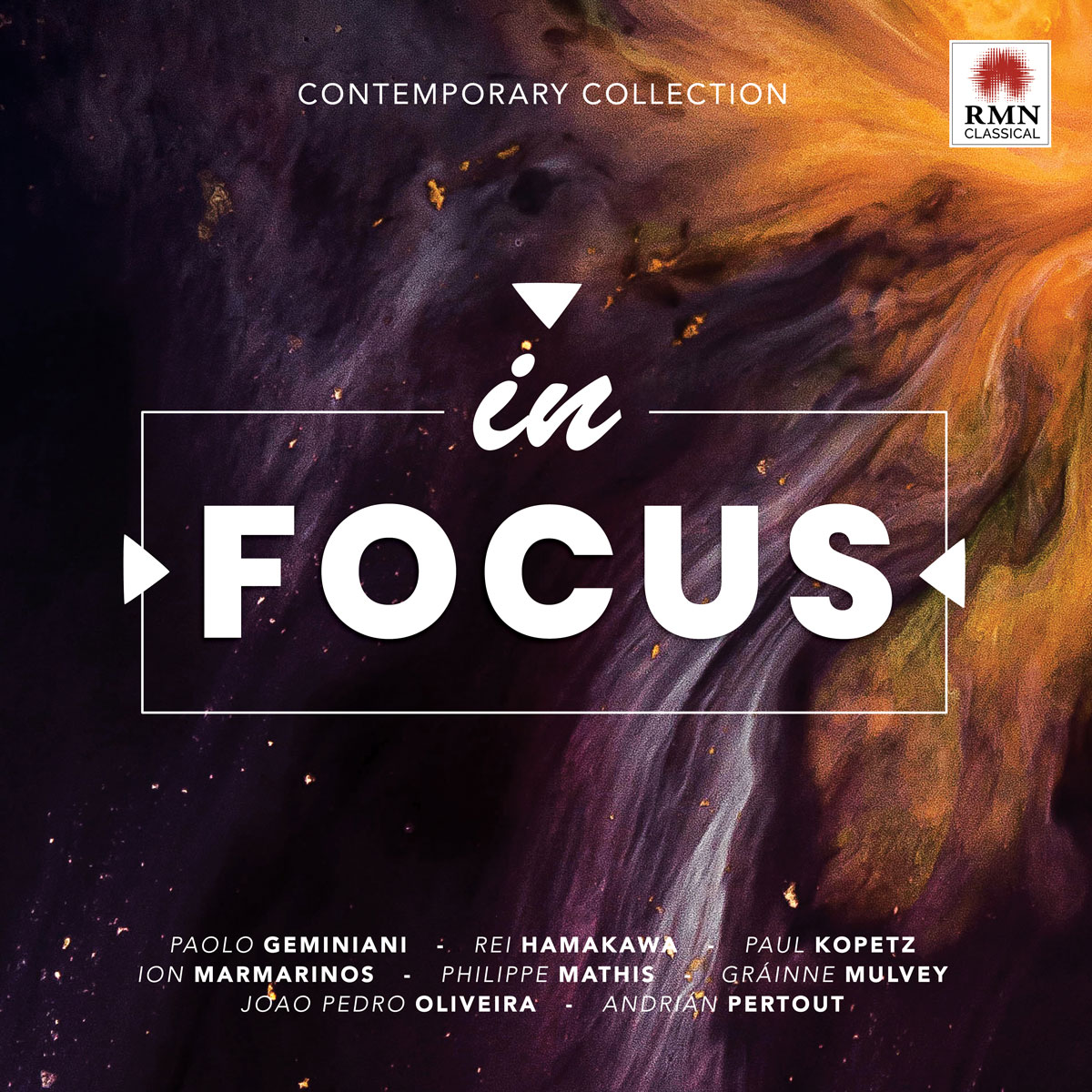MUSIC > In Focus

FULL ALBUM
Title: In Focus
Release Date: 7 May 2020
Label: RMN Classical
Produced by R. Romano
Cover design by RMN Classical
Cover photo by Joel Filipe
Performed by
(in order of playlist)
01. Peter Sheridan (bass flute)
02. Harriet Burns (soprano), Horacio López Redondo (piano)
03. Ascanio Quartet
04. Philippe Mathis (piano)
05. Diana Dias (bassoon)
06. Ensemble MISE-EN
07. Paul Kopetz (conductor)
08 - 10. Hirofumi Uematsu (piano)
In Focus by Various Artists
| N. | Play | Title | Composer | Time |
| 01 | Here and Now | Andrián Pertout | 07:50 | |
| 02 | The Horses | Ion Marmarinos | 09:30 | |
| 03 | Sommessi Presagi | Paolo Geminiani | 07:14 | |
| 04 | The Elves | Philippe Mathis | 05:18 | |
| 05 | Heavy Metals | Joao Pedro Oliveira | 09:03 | |
| 06 | Interstices | Gráinne Mulvey | 09:11 | |
| 07 | In Years Thou Art Still Young | Paul Kopetz | 07:14 | |
| 08 | Untranslatable Words: Hiraeth | Rei Hamakawa | 01:59 | |
| 09 | Untranslatable Words: Forelsket | Rei Hamakawa | 02:11 | |
| 10 | Untranslatable Words: Komorebi | Rei Hamakawa | 02:45 |
‘Here and Now’ was commissioned by Julian Burnside AO QC and especially composed for ‘low flutes’ specialist and director of Monash University Flute Ensemble Peter Sheridan (Melbourne, Australia). The work — a concerto featuring alto flute, bass flute, contrabass flute and subcontrabass flute, as well as an electroacoustic ‘tape’ element consisting of hyperbass flute melodic samples (not to mention a secondary biphonic soundscape framing a bass flute cadenza and featuring the juxtaposition of contrabass, subcontrabass and hyperbass flute low Cs) — represents a Hommage à Ernst Krenek (1900-1991) and serves as an exploration of Krenek’s twelve-tone modality as presented in Lamentatio Jeremiae prophetae, Op. 43 (1942) within the utilization of two contrasting scales: Minor Bitonal Scale (C, Db, Eb, F#, G and A) and Major Bitonal Scale (C, Db, E, F#, G and Bb). The above mentioned scales are categorized by Masaya Yamaguchi in The Complete Thesaurus of Musical Scales (2006) as 6-30Sa and 6-30MSa (with the vectors 224223 and 224223 respectively) and form part of his ‘80 Six-Note Subsets in 35 Vectors’. A series of twelve 6-note chords (constructed from transformations derived from the two bitonal scales) provide all the melodic and harmonic materials of each movement — this series essentially acting as a ‘chaconne’ (variation on a repeated short harmonic progression) in the second movement.
The music attempts to reflect the vivid theatricality demonstrated in the poem of Ted Hughes. The composer perceives this poem as the struggle between Angels (horses) and forces of evil. The primary motivic figure in the vocal line on which further variations are based, articulates an Arabic ambience which connotes the mystery, eroticism and charm of wild Arabic horses, expressed here with an intervallic structure of minor seconds, minor and major thirds. Through a lyrical vocal writing, the constant transposition of these intervals results in a continuously changing tonality, which symbolizes restlessness and struggle, set against the piano’s rhythmic variations which imitate the horse’s running pace.
The work for string quartet has won various competitions among which:,
1. First prize at 15° National Music Competition "Città di Barcellona Pozzo di Gotto" (Messina, Italy), 5 May 2013
2. Selected by the Florence String Quartet, Florence (Italy), 27 August 2014
3. Finalist at the Alfred Schnittke International Composers' Forum & Competition 2016. KLK New Music Leopoli (Ucraina), 30 November 2016 (http://klknewmusic.com/competitions/alfred-schnittke/as2016/)
Also, it was performed by
- Ascanio Quartet (here published): Damiano Babbini, Laurence Cocchiara violini, Costanza Pepini viola, Catherine Bruni violoncello. "Rassegna Domenica del Quartetto" at Palazzo Medici-Ricciardi, Florence, 7 settembre 2014
- Phoenix String Quartet: Mykola Haviuk, Petro, during the ALFRED SCHNITTKE International Composers' Forum & Competition 2016. Concert Hall of the Lviv Philharmonic Society.
1. First prize at 15° National Music Competition "Città di Barcellona Pozzo di Gotto" (Messina, Italy), 5 May 2013
2. Selected by the Florence String Quartet, Florence (Italy), 27 August 2014
3. Finalist at the Alfred Schnittke International Composers' Forum & Competition 2016. KLK New Music Leopoli (Ucraina), 30 November 2016 (http://klknewmusic.com/competitions/alfred-schnittke/as2016/)
Also, it was performed by
- Ascanio Quartet (here published): Damiano Babbini, Laurence Cocchiara violini, Costanza Pepini viola, Catherine Bruni violoncello. "Rassegna Domenica del Quartetto" at Palazzo Medici-Ricciardi, Florence, 7 settembre 2014
- Phoenix String Quartet: Mykola Haviuk, Petro, during the ALFRED SCHNITTKE International Composers' Forum & Competition 2016. Concert Hall of the Lviv Philharmonic Society.
Elves are beings that are part of the legends and mythology of Northern Europe. Philippe Mathis' piano piece creates an ethereal soundscape to evoke such characteristics as those of an enchanted forest where the little fairies may live, beneficial to the world. "The Elves" is a luminous work with wild passages and broad melodic lines that create a captivating and hypnotic atmosphere. The harmonies, also, remind the fantastic world of the Elves as seen in modern media such as books, films and - why not - video games.
Heavy Metals, for bassoon and electronics, belongs to a group of several works for instruments and electronics, written by João Pedro Oliveira that are inspired by nature's elements.
Each of these pieces is related to the characteristics of the element that was used as inspiration.
In the case of Heavy Metals, the weight associated with physical matter is reflected in the use of gestures, phrases and musical elements that tend to progress toward the low frequencies, and then still are extended by the electronics. Also, certain sound distortions caused by the interaction between the electronics and the bassoon, propose a subtle reference to the rock style that proliferated in the 70s and 80s.
Each of these pieces is related to the characteristics of the element that was used as inspiration.
In the case of Heavy Metals, the weight associated with physical matter is reflected in the use of gestures, phrases and musical elements that tend to progress toward the low frequencies, and then still are extended by the electronics. Also, certain sound distortions caused by the interaction between the electronics and the bassoon, propose a subtle reference to the rock style that proliferated in the 70s and 80s.
Interstices by definition mean small openings between objects, especially adjacent objects, or objects set closely together, as between cords or atoms in a crystal. In this work these gaps are represented by the spaces between non-pitched sound and pitched sounds. The non-pitched sounds open the piece and gradually grow into the pitched sounds. Another element is the register - this is restricted to a few diffuse sounds at the beginning, confined to a particular register until, eventually, it expands to cover the whole aggregate of pitches available. The textures range from sparse to rhythmic dense activity and fade out to end the piece.
‘In Years Thou Art Young’ comes from my bilingual chamber opera ’Tales of Scheherazade’ (in Persian and English), based on the legendary collection of Eastern folk tales ‘One Thousand and One Nights’. This intoxicating mix of Western and Eastern cultures tells stories of love, passion, betrayal, loyalty, revenge and triumph in adversity. As Scheherazade attempts to save her sister from imminent death at the hands of the Sultan with a penchant for having his way with virgins and beheading them the morning after, she distracts him night after night by spinning never-ending stories.
In their duet also from Act 3, the rivals for Aziz’ affections, Zohrejabin and Azizeh, face each other engulfed in vastly different emotions. Azizeh (sung by Shirin Majd) is in absolute sorrow over the realisation that the love of her life, Aziz, has in fact fallen in love with the vampish Zohrejabin (sung by Judit Molnar). On the other hand, Zohrejabin expresses an air of triumph and contentment in securing Aziz’ affections.
In their duet also from Act 3, the rivals for Aziz’ affections, Zohrejabin and Azizeh, face each other engulfed in vastly different emotions. Azizeh (sung by Shirin Majd) is in absolute sorrow over the realisation that the love of her life, Aziz, has in fact fallen in love with the vampish Zohrejabin (sung by Judit Molnar). On the other hand, Zohrejabin expresses an air of triumph and contentment in securing Aziz’ affections.
The suite of three works is based on the idea that some words are virtually untranslatable from one language to another. The three words selected have no comparable term in other languages, and it is impossible to capture the idea of the meaning unless a lengthy phrase to describe such concept is used. The composer here attempts to express such terms through piano pieces. The three words are selected from different languages and made into a three-movement suite. The compositions are relatively easy to perform to ensure that children are able to play them as well.
1. Hiraeth (Welsh): \n. A homesickness for somewhere you cannot return to, the nostalgia and the grief for the lost places of your past, places that never were. Hiraeth shares some similarities with the wistfulness of saudade, but is a kind of homesickness that the Welsh feel for the Wales of the past, and is tinged with a healthy dose of sadness and longing [1]."
2. Forelsket (Norwegian): \n. The indescribable euphoria experienced as you begin to fall in love. Maybe this is something you've yet to experience, or maybe you've had it happen to you repeatedly. Either way, it's wonderful. Research has shown that forelsket is most likely to occur when you wear your heart on your sleeve [1]."
3. Komorebi (Japanese): \n. The sunlight that fi lters through the leaves of the trees. It may be temporarily blinding, but it's most de nitely beautiful. There is something wonderfully evocative and uniquely magical about sunlight fi ltered through green foliage [1]."
References
[1] Ella Frances Sanders, "Lost in Translation: An Illustrated Compendium of Untranslatable Words", Square Peg, 2015.
1. Hiraeth (Welsh): \n. A homesickness for somewhere you cannot return to, the nostalgia and the grief for the lost places of your past, places that never were. Hiraeth shares some similarities with the wistfulness of saudade, but is a kind of homesickness that the Welsh feel for the Wales of the past, and is tinged with a healthy dose of sadness and longing [1]."
2. Forelsket (Norwegian): \n. The indescribable euphoria experienced as you begin to fall in love. Maybe this is something you've yet to experience, or maybe you've had it happen to you repeatedly. Either way, it's wonderful. Research has shown that forelsket is most likely to occur when you wear your heart on your sleeve [1]."
3. Komorebi (Japanese): \n. The sunlight that fi lters through the leaves of the trees. It may be temporarily blinding, but it's most de nitely beautiful. There is something wonderfully evocative and uniquely magical about sunlight fi ltered through green foliage [1]."
References
[1] Ella Frances Sanders, "Lost in Translation: An Illustrated Compendium of Untranslatable Words", Square Peg, 2015.

